Innuendo is the fourteenth studio album by the British rock band Queen, released on 4 February 1991 by Parlophone in the United Kingdom and it is the band's first studio album to be released by Hollywood Records in the United States. Produced by David Richards and the band, it was the band's last album to be released in lead singer Freddie Mercury's lifetime, and their most recent one to be composed of entirely new material, save for The Cosmos Rocks by the Queen + Paul Rodgers collaboration. It reached the No. 1 spot on the UK album charts for two weeks, and also peaked at No. 1 in Italy, the Netherlands, Germany, and Switzerland, staying at No. 1 for three weeks, four weeks, six weeks, and eight weeks, respectively. It was the first Queen album to go Gold in the US upon its release since The Works in 1984.

Queen is the debut studio album by the British rock band Queen. Released on 13 July 1973 by EMI Records in the UK and by Elektra Records in the US, it was recorded at Trident Studios and De Lane Lea Music Centre, London, with production by Roy Thomas Baker, John Anthony and the band members themselves.

"Tie Your Mother Down" is a song by the British rock band Queen, written by lead guitarist Brian May. It is the opening track and the second single from their 1976 album A Day at the Races. On its original release as a single in 1977 the song peaked at 31 in the UK Singles Chart. More than 20 years later, it was released as a double a-side to "No-One but You " where it reached 13 in UK Singles Chart. On the album the song is preceded by a one-minute instrumental intro featuring a Shepard tone melody, performed by Brian May, which is reprised in the ending of "Teo Torriatte": this was intended to create a "circle" within the album.
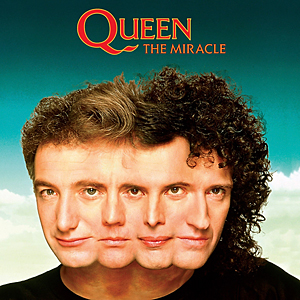
The Miracle is the thirteenth studio album by the British rock band Queen, released on 22 May 1989 by Parlophone Records and Capitol Records in both the United Kingdom and the U.S. respectively, where it was the band's only studio album to be released on latter label. The album was recorded as the band recovered from Brian May's marital problems and Freddie Mercury's HIV diagnosis in 1987. Recording started in January 1988 and lasted for an entire year. The album was originally going to be called The Invisible Men, but three weeks before the release, according to Roger Taylor, they changed the name to The Miracle. It was also the last Queen album with a photo of the band on the front cover.

Hot Space is the tenth studio album by the British rock band Queen. It was released on 4 May 1982 by EMI Records in the United Kingdom and by Elektra Records in the United States. Marking a notable shift in direction from their earlier work, they employed many elements of disco, funk, R&B, dance, pop and new wave music on the album. This made the album less popular with fans who preferred the traditional rock style they had come to associate with the band. Queen's decision to record a dance-oriented album germinated with the massive success of their 1980 hit "Another One Bites the Dust" in the US.

"Innuendo" is a song by the British rock band Queen. Written by Freddie Mercury and Roger Taylor but credited to Queen, it is the opening track on the album of the same name (1991), and was released as the first single from the album. The single debuted at number one on the UK Singles Chart in January 1991, the band's first number-one hit since "Under Pressure" nearly a decade before, and additionally reached the top ten in ten other countries. It is included on the band's second compilation album Greatest Hits II.
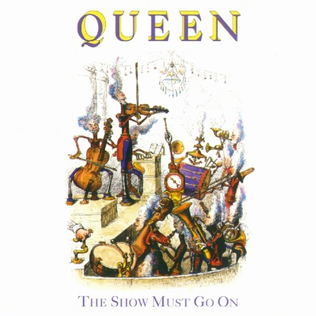
"The Show Must Go On" is a song by British rock band Queen, featured as the twelfth and final track on their 1991 album, Innuendo. It is credited to Queen, but written mainly by Brian May. The song chronicles the effort of frontman Freddie Mercury continuing to perform despite approaching the end of his life, although his diagnosis with HIV/AIDS had not yet been made public in spite of ongoing media speculation claiming that he was seriously ill. When the band recorded the song in 1990, Mercury's condition had deteriorated to the point that May had concerns as to whether he was physically capable of singing it. May recalls; "I said, 'Fred, I don't know if this is going to be possible to sing.' And he went, 'I'll fucking do it, darling'—vodka down—and went in and killed it, completely lacerated that vocal".
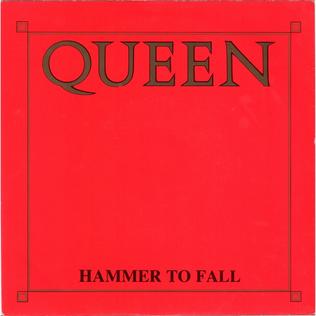
"Hammer to Fall" is a 1984 song by the British rock band Queen. Written by guitarist Brian May, the song is the eighth track on their 1984 album The Works. It was the fourth and final single to be released from that album, although the single version was edited down by thirty seconds from the version on the album. Different sleeves were used to package this single and the live picture sleeve is now a collector's item. The song harks back to the old roots of the band, being built around a hard angular and muscular riff.
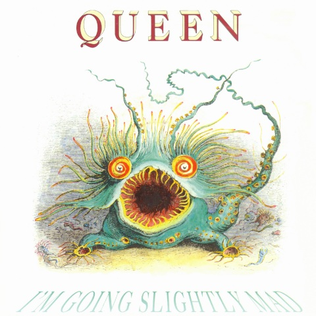
"I'm Going Slightly Mad" is a song by the British rock band Queen. Written by Freddie Mercury but credited to Queen, with uncredited lyrical contributions by Peter Straker, it was released as the second single from the band's 1991 album Innuendo. The song was released as a single on 4 March 1991, a month after the release of the album. The lyrics and the accompanying music video project the song as humorous and lighthearted, despite the lyrics dealing with the mental decline Mercury was experiencing as one of the effects of advancing AIDS.

"Who Wants to Live Forever" is a song by the British rock band Queen. A power ballad, it is the sixth track on the album A Kind of Magic, which was released in June 1986, and was written by lead guitarist Brian May for the soundtrack to the film Highlander. Queen was backed up by an orchestra, with orchestrations by film score composer Michael Kamen. The song peaked at No. 24 in the UK charts. In 1991, it was included in the band's second compilation album Greatest Hits II.

"Too Much Love Will Kill You" is a song written by British guitarist Brian May of Queen, Frank Musker and Elizabeth Lamers. The song reflected the breakdown of May's first marriage and attraction to his future wife, Anita Dobson. It was first recorded by Queen around 1988 or before, and was intended to be on the band's The Miracle album in 1989, but did not make the cut due to legal disputes following the band's decision that all songs on the album would be written by the group as opposed to individuals.
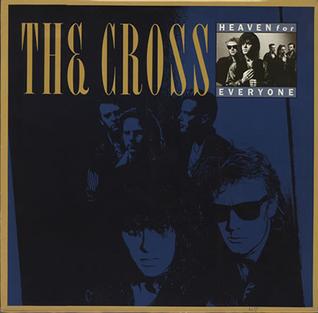
"Heaven for Everyone" is a song written by British rock band Queen drummer Roger Taylor. It originally appeared on his side project the Cross's album Shove It, with Freddie Mercury as a guest vocalist, and it is the album's fourth track. It was reworked with Queen's music and appeared in their fifteenth and final studio album, Made in Heaven (1995), where it was the seventh track, and was released as the first single by Parlophone – four years after Mercury's death. Queen's version reached number two on the UK Singles Chart while peaking at number one in Hungary and becoming a top-ten hit in several other European nations. In 1999 it was included in Queen's compilation album Greatest Hits III.

"Friends Will Be Friends" is a song performed by Queen, written by Freddie Mercury and John Deacon, released on 9 June 1986 as a single for the album A Kind of Magic. It was the band's 30th single in the UK upon its release, reaching number 14 in the UK.
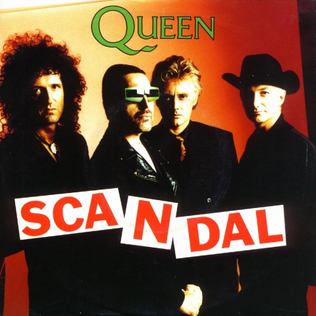
"Scandal" is a song by the British rock band Queen. It was released as the fourth single from their 1989 album The Miracle and peaked at #25 in the UK. The single was released in the United States but failed to chart.
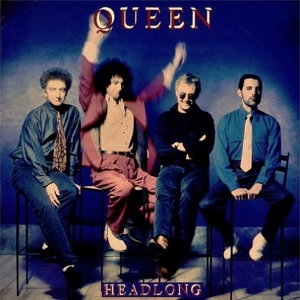
"Headlong" is a song by British rock band Queen, released as the third single from their fourteenth studio album, Innuendo (1991). The song was written by Queen guitarist Brian May, who intended to record it for his then-upcoming solo album Back to the Light (1992), but when he heard Queen lead singer Freddie Mercury sing the track, he allowed it to become a Queen song. As with all the songs on Innuendo, the track was promptly credited to the entire band.

"It's a Hard Life" is a song by the British rock band Queen, written by lead singer Freddie Mercury. It was featured on their 1984 album The Works, and it was the third single from that album. In 1991 it was included in the band’s second compilation album Greatest Hits II.

"The Invisible Man" is a song by the British rock band Queen, written by drummer Roger Taylor but credited to Queen. The song is sung mostly by Freddie Mercury, with vocal contributions from Taylor. The song was released in August 1989 as the third single from the bands album The Miracle. Taylor claims that he got the inspiration to create the song while reading a book, and the bassline instantly came to his imagination. The song title was inspired by the H. G. Wells novel of the same name.

"The Miracle" is the fifth and final single from Queen's 1989 studio album of the same name. It was composed by the entire band, though Freddie Mercury and John Deacon were the main writers. It was released as a single on 27 November 1989 and it was the band's final single release of the 1980s.
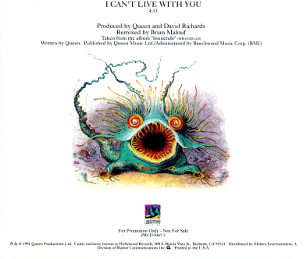
"I Can't Live with You" is a song by the British rock band Queen, which was released in 1991 as the fourth single from their fourteenth studio album Innuendo. The song was written by Brian May but credited to all four members of Queen. It was produced by Queen and David Richards. "I Can't Live with You" was released as a promotional single in the United States only, where it reached No. 28 on the Billboard Album Rock Tracks chart in June 1991.
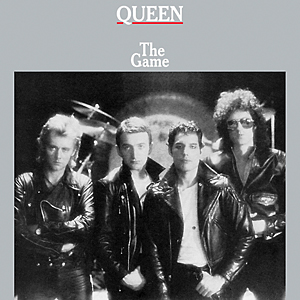
The Game is the eighth studio album by the British rock band Queen. It was released on 30 June 1980 by EMI Records in the UK and by Elektra Records in the US. The Game features a different sound from its predecessor, Jazz (1978). The Game was the first Queen album to use a synthesizer.
